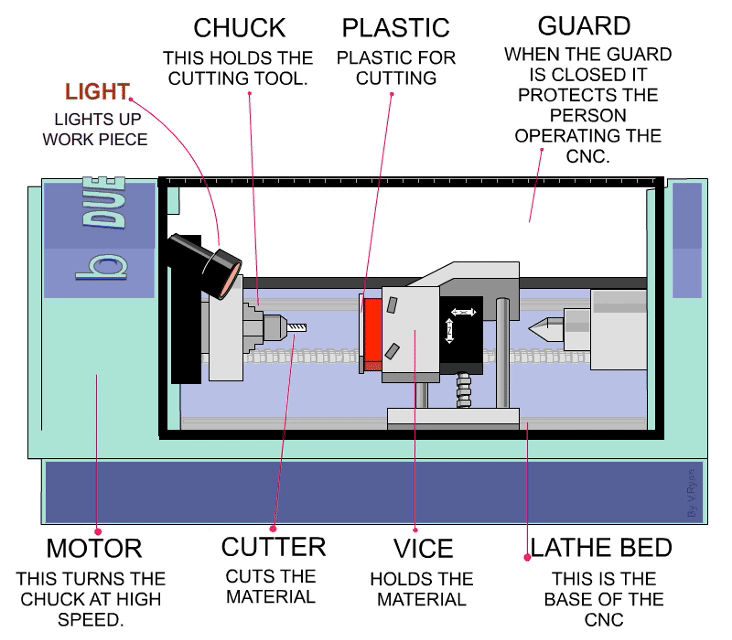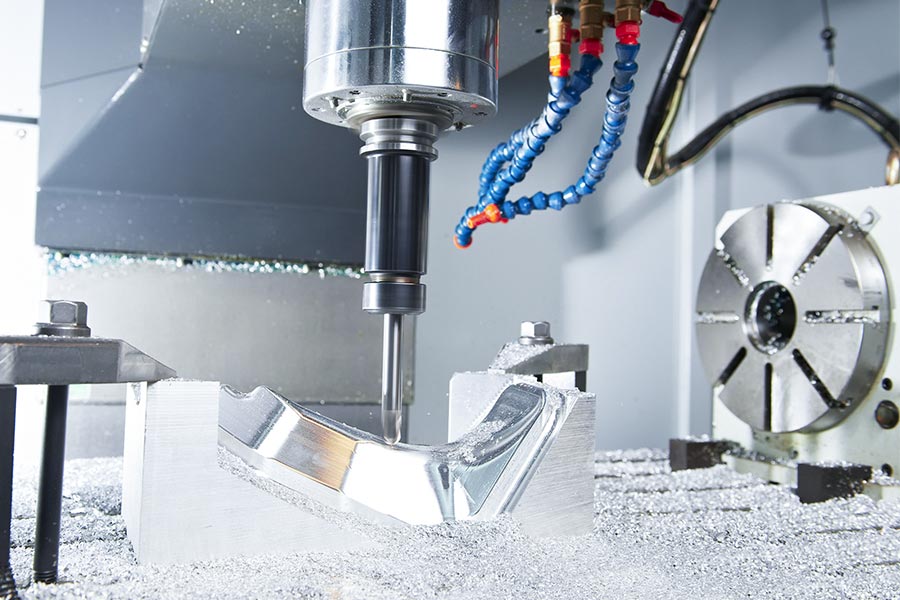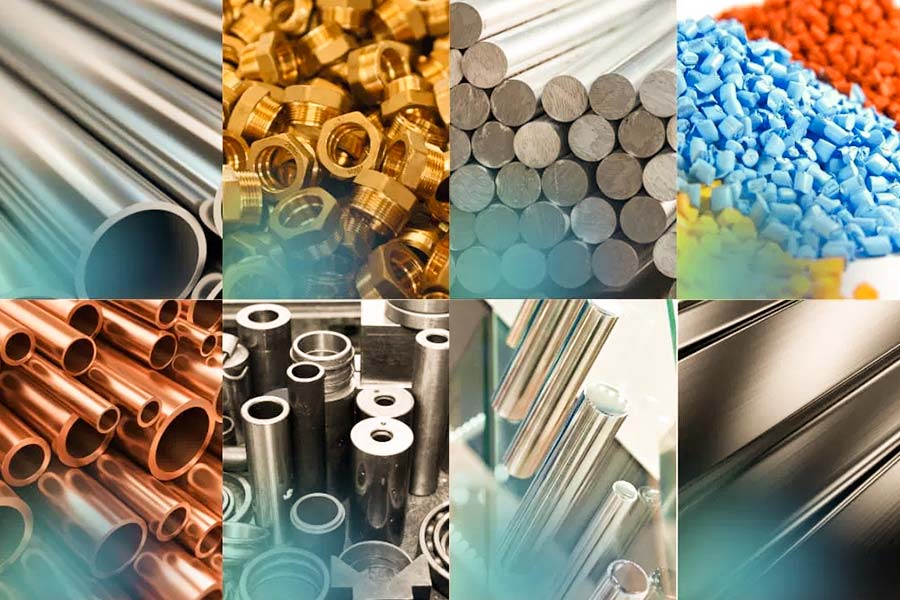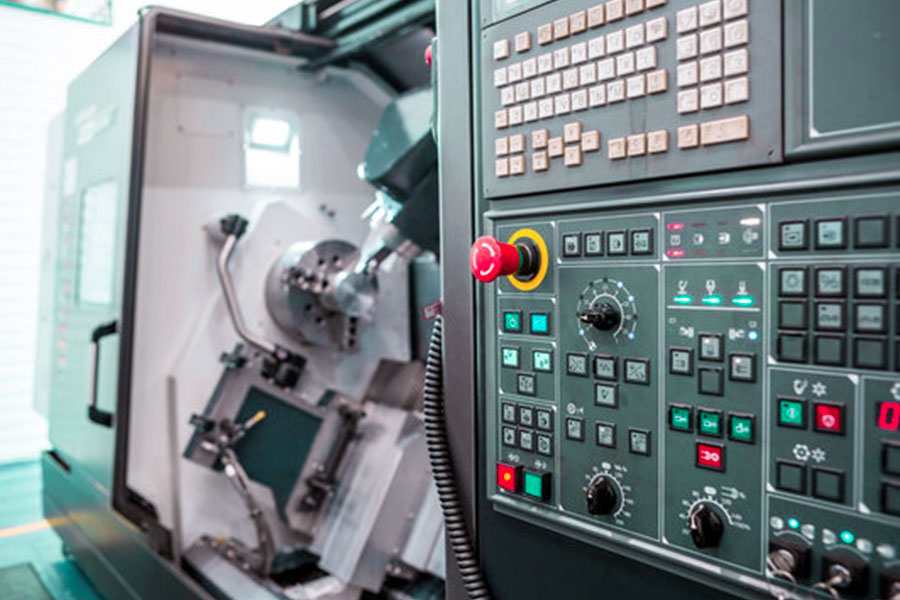CNC milling is a machining technique of high precision. It accepts a computer program as the program controller of the milling machine. CNC milling service in contemporary manufacturing is highly suitable for new product development because it has high processing speed and precision, and every processing outcome is identical. Multi-axis processing function is the substance of CNC milling. The most elementary 3-axis milling machine can accomplish the majority of processing work, and the very advanced 5-axis milling machine can machine more complex shapes.
This article will comprehensively introduce the processing process, material utilized and operating mode of CNC milling technology, and present readers with an in-depth CNC milling guide.

What is CNC milling?
CNC milling is the process of manufacturing by transforming digital models into actual parts. First, the operator clamps the metal workpiece, plastic and other materials onto the fixture or machine tool table, and then places the appropriate milling cutter on the spindle. After preparation, the operator will feed the processing program, which is entered by CAD or CAM software.
The current CNC milling machine allows the tool to be driven in elastic directions X, Y, and Z. Some advanced machine tools are also equipped with a fourth axis (A axis) and fifth axis (B/C axis). The rotational axes allow the tool to produce complex motions like beveling and circular motion, and thus three-dimensional curved surfaces can be processed without re-clamping. Compared with traditional manual milling machines, multi-axis CNC milling machine not only produces more complex parts, but also possesses higher precision and efficiency in processing, particularly suitable for the mass production of precision parts in industries.

What is the complete machining process of CNC milling?
CNC milling machining is a precise manufacturing process, and its whole process can be split into the following main steps:
1.Engineers design 3D models
Our engineers design the 3D models of products with CAD software. This includes the meticulous marking of each dimension, tolerance and surface treatment specifications to ensure the accuracy of the following CNC milling. Our design team has more than 10 years of experience in this area.
2.Programmers convert machining instructions
After completing the design, we will use CAM software to convert the 3D model into G code that is readable by the CNC machine tool. This conversion converts the design drawing into machine language, telling the machine how to move the tool and change speed and feed rate.
3.Operators prepare processing equipment
Our operators will select the correct tool according to the material. For aluminum alloy processing, they employ a 3-edge milling cutter and keep the cutting speed at 2000 rpm. The workpiece will be firmly clamped by a vacuum suction cup to prevent movement while processing.
4.CNC machine tool automatic cutting and shaping
CNC milling machining is begun officially. After the CNC system reads the G code, the spindle rotates at high speed with the tool to mill the material along the designed route. The 5-axis machine tool is able to process five directions at the same time, and even complex curved surfaces can be machined at a time. The processing accuracy of the German equipment newly brought by JS Company can reach up to 0.005mm.
5.Quality inspectors rigorously check dimensions
The processed parts must be inspected three times. First, the basic dimensions are checked by a caliper, secondly, the precision of the surface is checked by a three-dimensional device, and thirdly, shape is verified by a template. In case of deviations, our company will reprocess or correct, and the pass rate of the quality inspection has been above 99.8% for years.
6.Surface finishing
They need to be processed with grinding, polishing and so forth to improve the surface finish. Special processes such as anodizing and electroplating are also performed in certain cases to boost performance.
What materials can be machined by CNC milling?
1.Metal material (most commonly processed forms)
Our 5-axis CNC machines can easily process other metal materials. The most widely used material is aluminum alloy because it is light and easy to cut, and it is particularly suitable for manufacturing electronic product casings. Although stainless steel is extremely hard, our special tool equipped 5-axis CNC machines can also machine it to a perfect state. Our company adopts high-precision CNC milling machines to ensure the surface smoothness of the metal parts reaches Ra0.8 μm.
2.Engineering plastics (cost-effective choice)
POM (Saigang) and nylon are common plastic materials when CNC milling. They do not produce metal shavings during the process, hence are particularly useful when making wear-resistant parts such as gears and bearings. Considering the CNC milling machine cost, plastic processing is about 30%-40% cheaper compared to metal. JS company suggests this type of material for small batch prototypes.
3.Composite materials (specific application situations)
Carbon fiber and glass fiber composite materials can also be machined through CNC machining. Our engineers will utilize diamond coated cutting tools to ensure no material delamination. Even though the CNC milling machine cost for this type of material is high, it finds a vital application in aerospace. JS company provides custom process engineers on each composite material project.

How to operate a CNC milling machine?
1.Pre-startup inspection of the machine
The operator has to carry out a good inspection of all parts of the CNC milling machine. Our engineers will first inspect whether the lubricating oil level is within the standard and whether the air pressure is at the standard level of 0.5MPa. We have to warm up the machine for 5 minutes before each startup, especially when the ambient temperature is below 10℃ in winter.
2.Clamping and locating of the workpiece
Employing a precision vise or fixture with calibration is recommended to clamp the workpiece. We typically employ a dial indicator for aligning the workpiece so that the clamping error is controlled up to 0.03mm. For CNC milling turning composite processing of workpieces, it is recommended to employ a rotary table to improve the processing efficiency.
3.Tool installation and parameter setting
We select the appropriate milling cutter according to the processing requirement. While installing the tool, use a torque wrench to ensure that the clamping pressure is moderate. All the tools need to be calibrated to ensure accurate measurement of the tool length and diameter compensation value.
4.Program loading and verification
Our engineers load the processing program into the CNC system by using a USB flash disk or the network. While processing a new program for the first time, it is suggested to lower the feed rate to 50% for test processing. New-generation CNC systems are generally provided with program simulation functions, and it can effectively avoid machining collisions.
5.Process monitoring
In the formal processing, the operator needs to observe the running status of the machine tool during the entire processing. Pay attention to process characteristics like cutting sound and chip shape. In some complex processes like CNC milling turning compound processing, it is suggested to carry out dimensional inspection after each 10-15 workpieces.
6.Post-processing cleaning and maintenance
After processing is complete, we will switch off the spindle first and carefully remove the workpiece. Clean the tool magazine and worktable very thoroughly. Put the correct amount of lubricating oil into the guide rails and screws to keep the machine in good health.

What is the difference between manual programming and CAM software program generation?
1.Differences in programming speed
When codes are programmed by workshop technicians manually, they need to calculate tool coordinates line by line. It would take a skilled technician 2 hours to perform programming for a base with a threaded hole. After the CAM software has read in the 3D model, the system calculates the tool path automatically, and the programming time for the same part reduces to 20 minutes.
2.Complex structure processing capability
Human programming is difficult to handle free-form surfaces, such as automobile turbine blades processed with five-axis processing. CAM software can control surface processing error within ±0.01mm by algorithm optimization. The 2023 CIMdata report shows that the processing efficiency of complex parts of enterprises with CAM software increased 62%.
3.Probability of human error
When codes are programmed manually by operators, misalignment of the decimal point or confusion of axes direction will be prone to occur. Figures from a German quality testing organization reported that the first pass rate of manual programming was 78% and that of programs automatically generated by CAM software was 95%.
4.Learning and use costs
It takes 3-6 months for the technicians to become proficient in manual programming, and CAM software usage training is 2-4 weeks. However, companies need to pay annual software license fees of approximately 20,000 to 80,000 yuan, and small processing factories prefer maintaining manual programmers.
Manual programming versus CAM programming
| Comparison items | Manual programming | CAM programming |
| Average programming time | 4.2 hours/piece | 0.7 hours/piece |
| Yield rate of complex parts | 82% | 96% |
| Personnel training cycle | 5 months | 3 weeks |
What is the role of the spindle in CNC milling?
1.Drive the tool to rotate for cutting
The spindle makes the milling cutter rotate at high speed through the motor to cut metal or plastic. Based on the hardness of the material, we modify the speed. Set to 8,000 rpm revolutions per minute when processing aluminum alloy and in cutting stainless steel, it is lowered to 2,500 rpm. In 5 axis CNC milling machine, the spindle needs to be attached to the rotary table in order to complete high-precision machining of the aero parts' surface.
2.Ensure machining accuracy
The radial spindle runout error has a direct impact on the part size. Machine tool spindle runout is as precise as 0.003 mm, which is 1/20th of the thickness of hair. This much accuracy makes the pitch error of threaded holes in the medical bone plate never more than ±0.01 mm.
3.Perform multi-angle processing
The 5 axis CNC milling spindle has the capability to tilt ±30 degrees for side wall machining. Recently in processing car turbine blades, we employed this feature to remove the process that originally required 5 clampings down to 1, reducing the production cycle by 60%.
4.Offer machining stability
In heavy cutting, the spindle should be capable of withstanding a torque greater than 800 N·m. In cutting mold steel, we will use a high-torque spindle and reduce the feed speed to 300 mm/min to prevent tool chipping.
5.Spindle performance
| Spindle Type | Maximum speed | Torque peak | Applicable scenarios |
| Standard three-axis spindle | 12,000 | 450 N·m | Ordinary metal cutting. |
| Five axis linkage spindle | 20,000 | 680 N·m | Complex surface machining. |
| High speed electric spindle | 42,000 | 180 N·m | Processing of small precision parts. |
Source: Haas Automation 2023 Technical White Paper.
What are the unique advantages of small CNC milling in machining?
As JS technical engineer, I shall show you the basic advantages of small CNC milling from the perspective of actual production:
1.Occupying less space but full functions
In comparison with large machines, small CNC milling machines occupy 40%-60% less area. Although our miniature machine tools are tiny in size, they are equipped with the same high-precision ball screws and linear guides as for big machines, with positioning accuracy as high as ±0.005mm, but can still sustain continuous processing of complicated surfaces. One of our assignments last year was to create a micro sensor housing for a new energy vehicle corporation, in which this ability was used to reduce the unit cost by 22%.
2.Energy consumption economy performance
During machining of aluminum alloy, the unit energy consumption of a small machine tool with 3kW spindle power is only 1/5 of the unit energy consumption of a large machine tool. This benefit means that small CNC milling is especially conducive to prototype development and experimental small-batch production. The electric control box processing solution we designed for a new energy vehicle company reduced the unit energy cost of consumption to 0.78 yuan by streamlining processes, saving more than $120,000 in electricity charges annually.
3.Advantages of mixed material processing
JS's proprietary database of cutting parameters can be used on 23 materials from 6061 aluminum alloy to PEEK engineering plastics. In the recently completed orthopedic implant project, Small CNC milling achieved cutting temperature control at 80℃±5℃ in titanium alloy and ceramic composite material transition processing, successfully avoiding phase change in the material.
4.Flexible operation
Following 48 hours of JS training, the operator will be able to fully master all of the small CNC milling machine's functions. Our control panel has a graphical interface, and our programming is 60% less complicated than traditional systems. It is particularly suitable for flexible production needs of numerous types and small lots.
5.Rapid process verification system
Once the customer has uploaded the drawing, our team will be able to produce a simulation video of the processing in 4 hours. Last year's collaborative electronic equipment project was completed from design freeze to first piece shipment in only 72 hours with 3 process iteration verifications.
Summary
From the above analysis, it can be seen that CNC milling technology has become the core processing method of modern manufacturing industry through the coordinated operation of digital control system and precision machinery. With the help of advanced CNC milling machining technology, we can perform high-precision molding processing on more than 50 kinds of engineering materials.
With the development of five-axis linkage technology and miniaturized equipment, complex parts that require multiple clamping in traditional processing can now be completed through multi-process integrated processing through single positioning. We provide mature CNC milling machining solutions, which can not only improve production efficiency by more than 30%, but also effectively control material loss rate and labor costs. This is an indispensable technical support system in the transformation of intelligent manufacturing.
Disclaimer
The content on this page is for general reference only. JS Series makes no express or implied warranties regarding the accuracy, timeliness, or applicability of the information provided. Users should not assume that the product specifications, technical parameters, performance indicators, or quality commitments of third-party suppliers are completely consistent with the content displayed on this platform. The specific design feature, material standards, and process requirements of the product should be based on the actual order agreement. It is recommended that the purchaser proactively request a formal quotation and verify product details before the transaction. For further confirmation, please contact our customer service team for professional support.
JS Team
JS is an industry leading provider of customized manufacturing services, dedicated to providing customers with high-precision and high-efficiency one-stop manufacturing solutions. With over 20 years of industry experience, we have successfully provided professional CNC machining, sheet metal manufacturing, 3D printing, injection molding, metal stamping and other services to more than 5000 enterprises, covering multiple fields such as aerospace, medical, automotive, electronics, etc.
We have a modern factory certified with ISO 9001:2015, equipped with over 100 advanced five axis machining centers to ensure that every product meets the highest quality standards. Our service network covers over 150 countries worldwide, providing 24-hour rapid response for both small-scale trial production and large-scale production, ensuring efficient progress of your project.
Choosing JS Team means choosing manufacturing partners with excellent quality, precise delivery, and trustworthiness.
For more information, please visit the official website: jsrpm.com
FAQs
1.How long does manual operation take?
The manual operation time of CNC milling machines mainly depends on the complexity and quantity of workpieces. It takes 10-30 minutes to clamp and set the tool for simple workpieces, but it takes 1-2 hours for complex workpieces. In mass production, after the first piece is debugged, automatic processing can be basically achieved, and manual inspection is only required occasionally.
2.How does the computer control a milling machine?
The computer controls the milling machine through the utilization of a pre-established G code program. After the program is loaded into the CNC system by the operator, the computer will accurately command the servo motor to maneuver the tool on the X/Y/Z axis and automatically execute the cutting process without any human involvement.
3.What is the distinction between 3-axis and 5-axis?
3-axis CNC can only be machined in the X/Y/Z direction and can be applied to flat parts. 5-axis CNC adds a rotary axis, and the tool can be tilted for machining, which can complete complicated curved surfaces such as impellers at one time, reducing the clamping error by 60%, which has particular applicability to the efficient batch production of precision molds and aircraft parts.
4.Why use multi-axis processing?
Multi-axis processing can reduce part clamping times and realize complex curved surface processing through one-time positioning. JS's five-axis CNC equipment can improve the machining accuracy of parts such as turbine blades to ±0.005mm, and the qualified rate is increased by 30%, which has particular applicability to the mass production necessities of aerospace precision parts.
Resources
Digital modeling and fabrication






